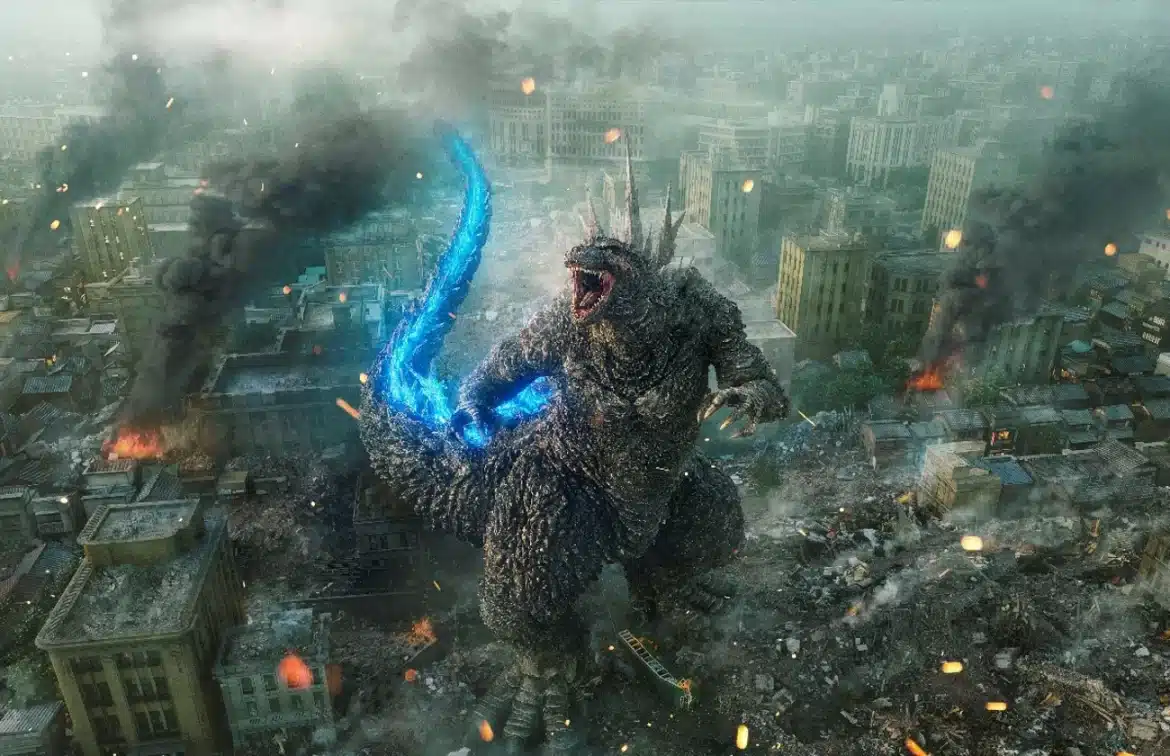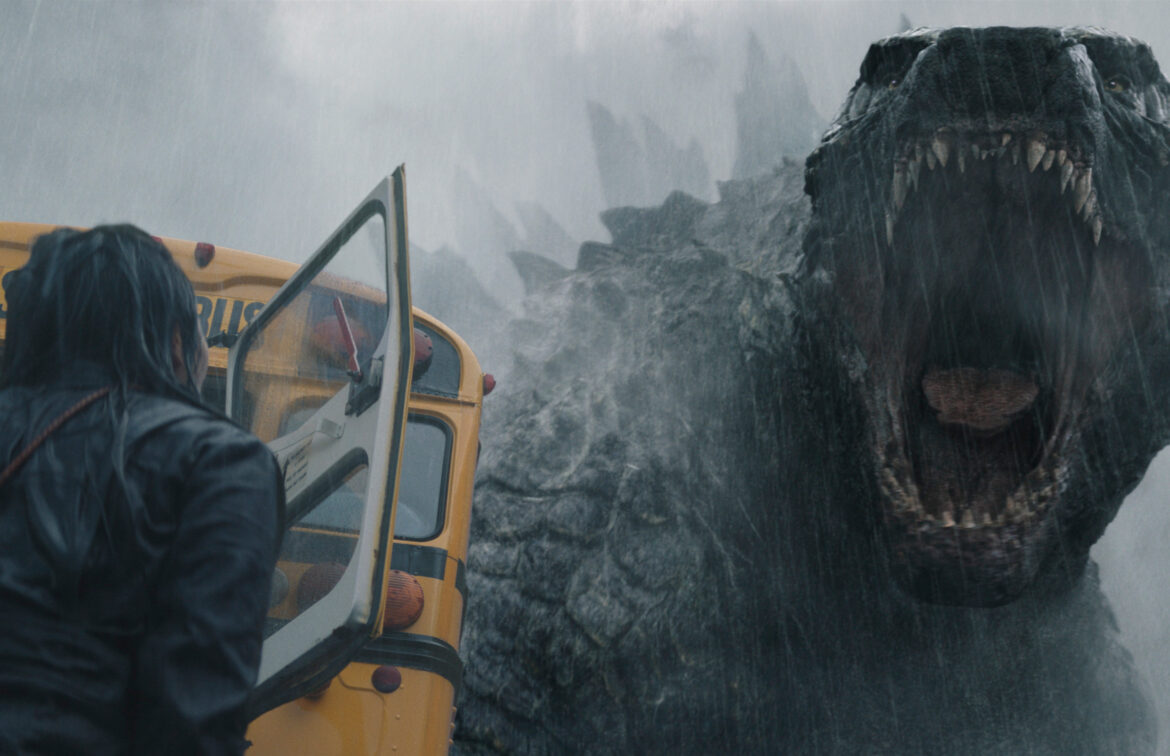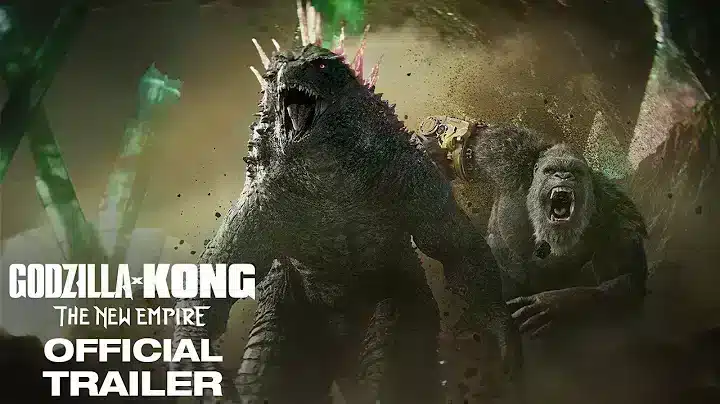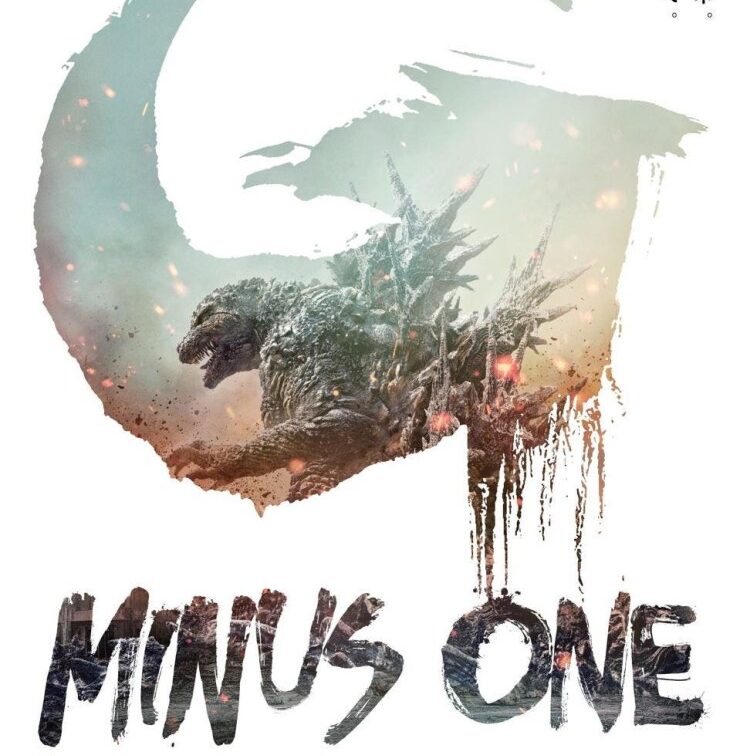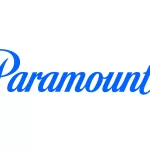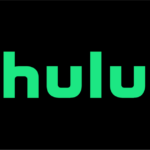As the world continues into what appears to be the darkest timeline, and as we celebrate Godzilla’s 70th anniversary, we continue to see the prescience of the Godzilla franchize and all of its metaphors and lessons. One cannot help but wonder if the original creators of Godzilla might have hoped that we’d no longer need him, afterall Godzilla began as an embodiment of the atom bomb in a devastated post-war Japan. Yet with more Godzilla properties than ever, each with their own story to tell, we see that in fact Godzilla can be a mirror for us all in our own way. (Or in the case of Godzilla x Kong: The New Empire, perhaps just a wacky romp.) We wanted to then take a look at Godzilla through the years, and how America and the world has embraced the monster that was created to reflect America’s own actions in war.
Origin of Godzilla
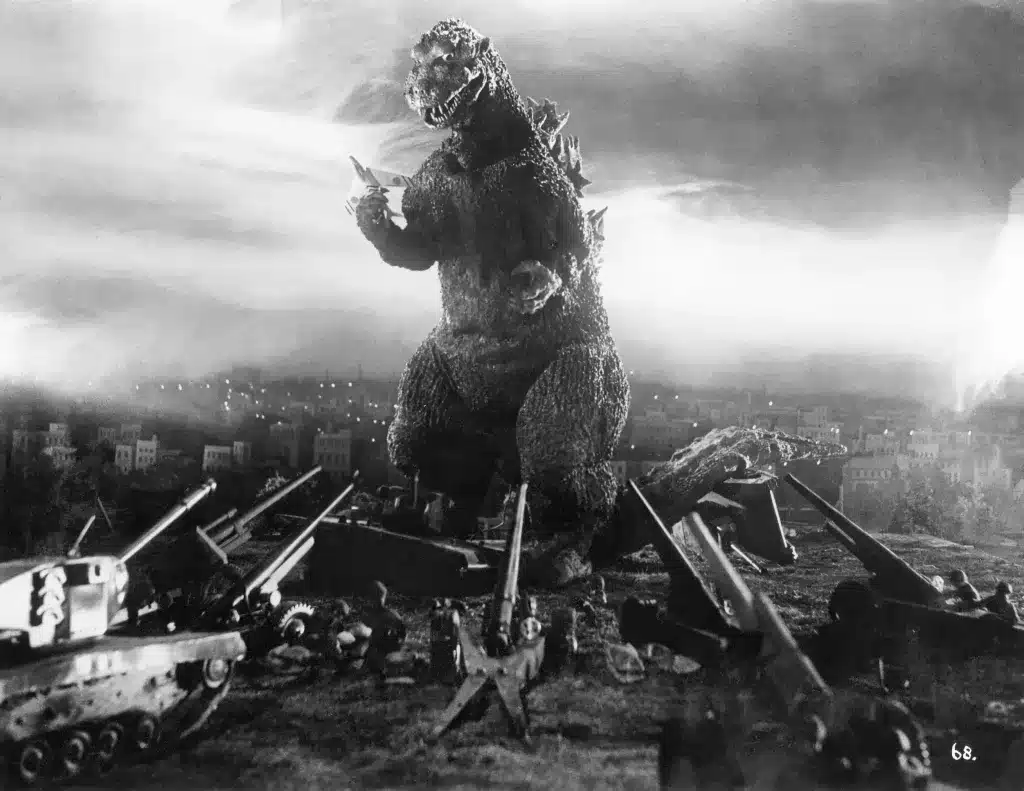
Production still of either Haruo Nakajima or Katsumi Tezuka portraying Godzilla via suitmation in Godzilla (1954). (Toho Company Ltd.)
Ishirō Honda, best known as the filmmaker behind the first Godzilla film, began his directorial career in 1949. Honda’s first films of note, Eagle of the Pacific (1953) and Farewell Rabaul (1954), portrayed Japan in a light that would come to define the Godzilla films, as a country whose citizens were increasingly struggling in the post-war era. Honda then took on the creature feature, which itself took inspiration from American films, with a uniquely Japanese perspective in Gojira (1954). Gojira was himself a reflection of the atom bomb, whose raw power and destructive capabilities mirrored for many Japanese audiences the callous, wanton wreckage of war, and specifically the destruction of Hiroshima and Nagasaki by American H-Bombs.
This set the tone for the more serious, wrathful portrayals of Godzilla, though many follow-ups would take a campier approach. Even as the portrayals of Godzilla though changed in tone, the creature’s origin will always echo war time destruction for many viewers.
Godzilla: King of the Monsters (1956)
According to Criterion.com, Honda’s Gojira became “the first foreign film to receive widespread distribution in the U.S.” Gojira however came over like many Japanese properties have (i.e. Robotech and Power Rangers), cut up, edited, and re-worked for an American audience. The greatest change, aside from the name which became Godzilla: King of the Monsters, is the introduction of Canadian actor Raymond Burr, best known now for his roles in the Godzilla franchise along with his titular role as Perry Mason. Godzilla: King of the Monsters (1956) became a commercial success in the United States, and thanks to its box office numbers the American edit was distributed internationally to further commercial success. Though Godzilla had begun as a local reaction to the war, viewed throgh the lens of its Japanese creators, Godzilla’s impact was now and forevermore a worldwide phenomen.
Expansion of the Godzilla Monster-verse
Toho took advantage of their hit property by releasing a Gojira sequel the following year, titled ‘Godzilla Raids Again’ (1955), which expanded the universe of monsters further with the introduction of Anguirus. Thereafter through the Showa era (each Godzilla era is tied to the emprerors in power), increasingly more and more titles would be released with additional creatures for Godzilla to fight, sometimes as antagonist and sometimes as protagonist. These new creatures include fan favorites such as Mothra in early 1964, Ghidorah released later that same year, and Mechagodzilla (sometimes portrayed as a man made machine) in 1974.
King Kong vs Godzilla (1962)
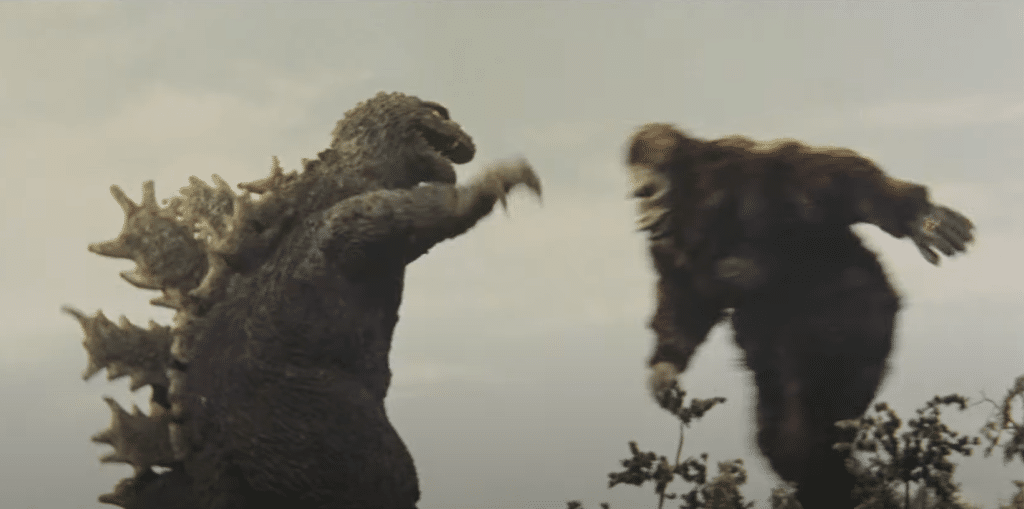
Battle sequence from King Kong vs Godzilla as seen in trailer. (Toho/Universal Int.)
During this same period, Godzilla had its first battle against King Kong, the popular creature first created in the eponymous 1933 film. In the appropriately titled ‘King Kong vs Godzilla’ (1962), the third film in the franchise and the return of Honda to the director’s chair, the two behemoths of the screen fight after both arriving (Kong unwillingly so) to Japan. Godzilla has since fought King Kong four more times, including most recently in the film Godzilla vs Kong (2021). In the forthcoming feature in the American MonsterVerse, Godzilla x Kong: The New Empire (2024), the trailer shows Kong will re-unite again with Godzilla; however, more likely as compatriots with a shared enemy instead of as foes.
The Heisei Era
After a period of levity and camp in the late Showa era Godzilla releases, IGN.com says, “Toho decided to bring the franchise back to its darker roots with a reboot: 1984’s the return of Godzilla.” This followed after the less than steller release of ‘Terror of Mechagodzilla’, which failed to perform and prompted Toho to consider the future of the Godzilla franchise anew. The Heisei era then saw a return to classic battles with the now beloved monsters of the franchise, including Godzilla vs. King Ghidorah (1991), Godzilla vs. Mothra (1992), Godzilla vs. Mechagodzilla II (1993). The era then culminated with Godzilla vs Destoroyah (1995), which sees Godzilla face his greatest threat to date (and perhaps his ultimate fate.)
America’s Godzilla
Despite previous localization efforts, including Godzilla: King of the Monsters (1956) and Godzilla 1985 (1985), Hollywood had yet to create an original Godzilla feature film. That is until Roland Emmerich’s Godzilla (1998) was released. Despite recouping its budget, the Godzilla film was considered a failure, leading to scrapped plans for a franchise. Critics like Ebert, who himself had scathing remarks for previous Godzilla films, in particular loathed this film, saying of the film, “What a cold-hearted, mechanistic vision, so starved for emotion or wit.” This would lead to a 16-year gap between attempts to breathe life into an American Godzilla film, with any planned sequel adapted instead into the animated series Godzilla: The Series (1998) which aired on Fox Kids for two seasons. Thanks ultimately to a more positive response to Godzilla (2014), produced by Legendary Pictures and co-produced and distributed by Warner Bros. Pictures, Americans now have a commercially successful (if not always critically) homegrown Godzilla franchise with Legendary Pictures’ MonsterVerse.
Godzilla’s Millenium Era
Immediately following America’s failed attempt at launching a Godzilla franchise, Toho began to release new films immediately beginning with Godzilla 2000: Millennium (1999) the year after Godzilla (1998) was relased. This kicked off the first era not tied to an emperor, which would become konwn as the Millenium Era. The Millenium Era featured the return of Mothra and King Ghidorah, in Godzilla, Mothra and King Ghidorah: Giant Monsters All-Out Attack, along with Mechagodzilla in Godzilla Against Mechagodzilla. CBR characterized the era as “unexpected”, saying the Era where each film was a “standalone project” that featured Godzilla as “no longer a hero or villain, but an animal who battled other monsters that threatened him.” The Millenium Era of Godzilla certainly sent a lot of monsters into the fray, with the final film of the era Godzilla: Final Wars (2004), which had Godzilla facing off against the most monsters in a feature to-date including Monster X, Keizer Ghidorah, Zilla, Rodan, Mothra, Manda, Gigan, King Caesar, Minilla, Anguirus, Kumonga, Kamacuras, Hedorah, and Ebirah.
Godzilla (2014) and the Legendary Pictures MonsterVerse
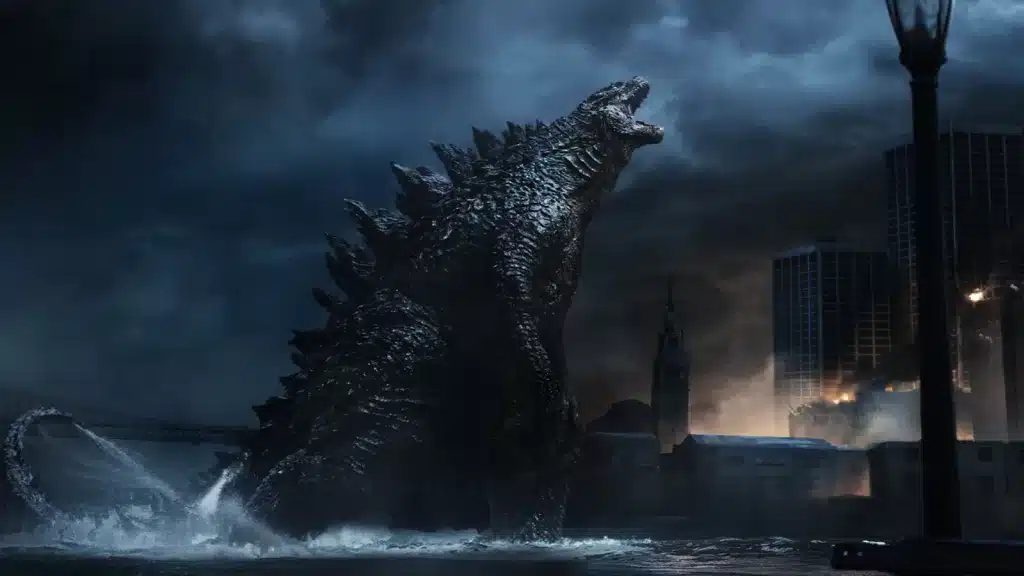
Godzilla (2014) (Source: Legendary Pictures)
In 2014, Gareth Edwards broke the mold, in America at least, by directing a successful Godzilla film that met with generally positive reviews from critics and by bringing in revenue that more tripled the production costs. Thus Godzilla (2014) was a certified hit. According to Max Borenstein, screenwriter for the film, in an interview with SyFy, the plan wasn’t always to create a ‘MonsterVerse’. However Borenstein said, “Legendary. Thomas Tull, who was CEO of Legendary at the time and the founder, was the real initial impetus and stan” to create the broader universe, which he set in motion when he tasked Borenstein to write Kong: Skull Island (2017). This film too met with overall critical success, and blockbuster numbers in the box office, which established the success of the MonsterVerse and allowed Legendary the chance to again bring the two titans together in Godzilla vs. Kong (2021).
Shin Godzilla (2016) and the Reiwa Era
Following the success of Edwards 2014 ‘Godzilla’, Toho was ready again to release a new Godzilla film after a twelve year hiatus since the relase of ‘Godzilla: Final Wars’ in 2004. Renowned filmmakers Hideaki Anno (Neon Genesis Evangelion) and Shinji Higuchi (Sinking of Japan, Lorelei: The Witch of the Pacific Ocean) came together to direct the film, based on Anno’s screenplay. Anno took inspiration from the tragedy and devastation of the 2011 earthquake and tsunami which hit Japan to revisit the fear and wanton desctructiveness Godzilla was first known for. Shin Godzilla became the highest grossing live-action film for Japan in 2016, and thanks to its success it not only brought in the Reiwa Era of Toho’s Godzilla films, but the movie also launched Anno’s own ‘Shin’ series which includes Shin Ultraman and Shin Kamen Rider.
Godzilla Minus One (2023)

Ryunosuke Kamiki as Kōichi Shikishima in Godzilla Minus One (Source: Toho Co., Ltd.)
Godzilla’s Reiwa era has been notable not just for Shin Godzilla but also for the number of animated releases, including Godzilla: Planet of the Monsters (2017), Godzilla: City on the Edge of Battle (2018), and Godzilla: The Planet Eater (2018). After the release of these titles on Netflix, there had been a five year pause in Godzilla relases in Japan. That is until Takashi Yamazaki (The Great War of Archimedes, Lupin III: The First) was asked to helm a new Godzilla film, which became ‘Godzilla Minus One’. ‘Godzilla Minus One’ retells the origin story of Godzilla, by revisiting its origins in WWII. Yamazaki referenced the initial ‘Godzilla’ (1954) film in many ways, paying homage to it while also going harder in its critiques of the military and the Japanese government. ‘Godzilla Minus One’ is still in theaters as of this writing; however, it’s already become a blockbuster hit and a critical success domestiaclly and internationally. With its incredible box office numbers, and an ending that leaves room for future sequels, there’s no doubt that future Godzilla films will attempt to follow this film’s success.
Monarch: Legacy of Monsters (2023)
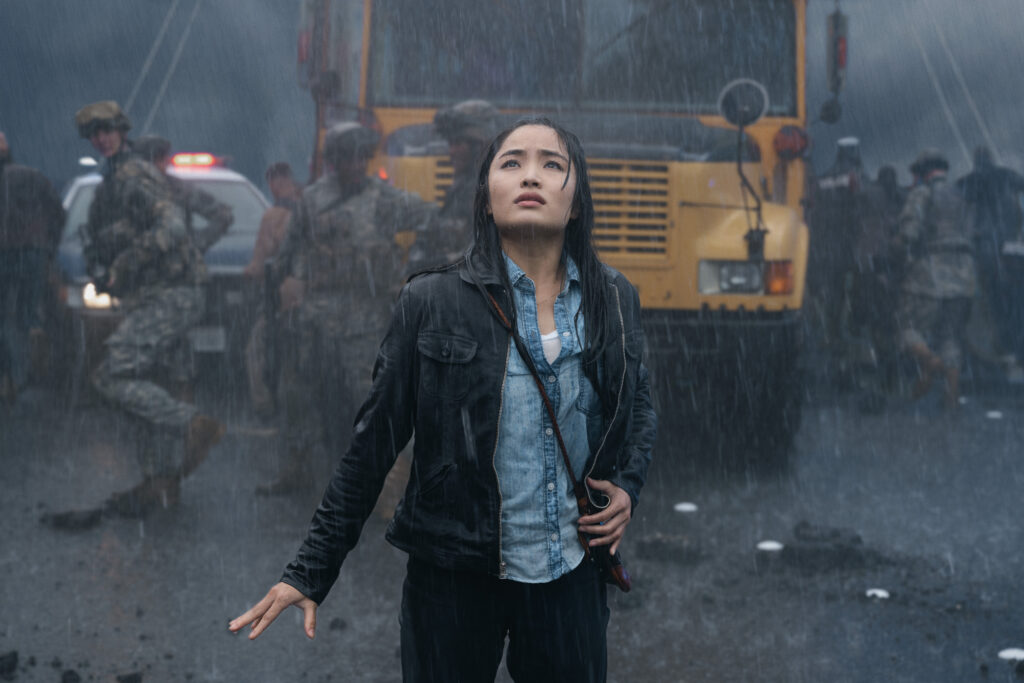
Anna Sawai in “Monarch: Legacy of Monsters,” coming soon to Apple TV+.
After the success of the American MonsterVerse thus far, Legendary Pictures developed two series for TV including an animated sequel to ‘Kong: Skull Island’, titled ‘Skull Island’ (2023). Simultaneously Legendary Pictures began work on Monarch: Legacy of Monsters, which looks at the organization first created for the MonsterVerse which has acted as a throughline for the films. As of this writing Monarch: Legacy of Monsters is still ongoing; however, much like ‘Godzilla Minus One’ it really embraces the real destruction and death behind the monster battles. Likewise it deals with the trauma of such events too, which echo back to the many events that have inspired Godzilla films through the years (H-Bombs, earthquakes, etc). Though it’s yet to see how the show will fit in the Godzilla canon overtime, already it’s been a wonderful companion to the more grounded films ‘Shin Godzilla’ and ‘Godzilla Minus One’, and it’s been a standout in the ‘MonsterVerse’.
The Future of the Godzilla Franchise
With ‘Godzilla Minus One’ still in theaters, only having recently opened up worldwide, it’s too early to say what’s to come from Toho. Though another film following the vein of this success seems inevitable. Its more clear what the future holds for Legendary Pictures’ MonsterVerse, as they have recently released a trailer for ‘Godzilla x Kong: The New Empire’ which appears to set up our primary monsters’ battle to the side as they face an external thread, most likely more monsters. Though this trailer has been met derisively when compared to ‘Godzilla Minus One’, it only further shows that Godzilla as a franchise can be so many things for so many people. Incredibly the words serious, camp, heartfelt, action packed, triumphant, and critiquing can all describe various titles (sometimes the same title) in the franchise.
Perhaps it’s not surprising when a franchise has a 70 year legacy, consisting of over 40 titles across film, TVs, books, etc., that it can have so much range. However it’s a testament to the many creators behind these titles, and to Godzilla itself a creature that is so much more than a monster but a mirror somehow on all aspects of humanity.
